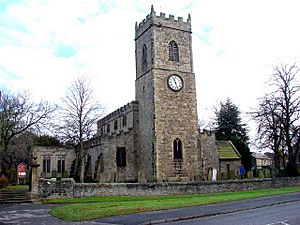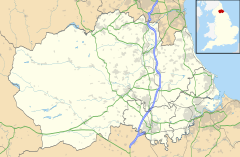Lanchester, County Durham facts for kids
Quick facts for kids Lanchester |
|
|---|---|
| Village | |
 All Saints’ Church, Lanchester |
|
| Population | 4,054 (2011) |
| OS grid reference | NZ165475 |
| Unitary authority |
|
| Ceremonial county | |
| Region | |
| Country | England |
| Sovereign state | United Kingdom |
| Post town | DURHAM |
| Postcode district | DH7 |
| Dialling code | 01207 |
| Police | Durham |
| Fire | County Durham and Darlington |
| Ambulance | North East |
| EU Parliament | North East England |
| UK Parliament |
|
Lanchester is a village in County Durham, England. It is about 8 miles (13 km) west of Durham city. The village is also about 5 miles (8 km) from Consett. In 2011, about 4,054 people lived there.
Long ago, Lanchester had a small mine for coal. This mine closed in the 1970s. For a long time, Lanchester's economy was mostly based on farming. Today, it is mainly a residential village. Many new homes have been built here since the late 1960s.
Contents
What's in a Name?
The name Lanchester has a long history. In the 2nd century AD, the area was known as Longovicium. This name came from an old British language. It meant something like "ship" and "a Roman village".
The "Lan-" part of the modern name comes from an Old English word. This word meant "long". The second part, "-chester", comes from the word "ceaster". This word means "a fort" or "an old Roman site". So, Lanchester means "long fort" or "long Roman site".
A Look Back in Time
The earliest known settlement here was a Roman fort. This fort was built by auxiliary soldiers. It is located just southwest of the modern village. The fort was called Longovicium.
The Roman Fort of Longovicium
The Roman fort of Longovicium was built around AD 140. It was part of a Roman road network. This road led north from Eboracum (which is now York). The fort was placed between two other Roman forts. These were Vindomora (Ebchester) and Vinovia (Binchester).
The fort covered almost 6 acres (2.4 hectares) of land. It was home to about 1,000 Roman foot soldiers and cavalry. The foundations of the fort are still well preserved today. However, only a small amount of digging has been done there. This happened in 1937.
Some of the stone from the old Roman fort was used to build All Saints' Church. You can even see a Roman altar in the church's porch. This altar is one of many found near the fort. It was discovered in 1893.
Some historians believe that the famous Battle of Brunanburh might have happened at this Roman fort. They think Brunanburh could mean 'stronghold of the River Browney'.
How Lanchester is Governed
Lanchester has its own electoral ward. This is an area used for local elections. In 2011, the population of this ward was 7,446 people.
Schools in Lanchester
Lanchester has several schools for young people.
- St Bede's Catholic School and Sixth Form College is a secondary school. It also has a sixth form for older students.
- There are two primary schools:
- Lanchester All Saints' RC Primary School
- Lanchester Endowed Parochial School. This school moved to a new building. The old school building is now the village hall. This school has a nursery, an infants department, and a juniors department.
Places of Worship
Lanchester has several churches.
All Saints Parish Church
The main parish church is called All Saints. It used to be known as St. Mary the Virgin. The first part of the church was built in the mid-12th century. It was made bigger in 1284 by Antony Bek. He was the bishop of Durham. The church tower was built around 1430.
Interesting things to see in the church include:
- The Norman chancel arch. This is an archway from the Norman period.
- Large stone columns in the nave. These columns likely came from the Roman fort.
- A Roman altar in the porch.
College of Lanchester
The parish of Lanchester used to be very large. It covered about 68 square miles (176 km²). To manage this large area, Bishop Antony Bek created a Deanery and a College of Canons at the church in 1284. He made the church bigger to fit more clergy.
The college had a Dean and seven Prebendaries. Each of them shared in the church's income. Bishop Bek created rules for the college. These rules were approved by King Edward I in 1293. The church also made money by being the only place selling religious items, like holy water, to nearby villages.
By the 15th century, the college was not used as much. The church itself started to fall apart. There were "gaping ruins" in the church and the clergy's houses. When Henry VIII closed down the monasteries, the college and deanery were ended. The church then became a regular parish church again.
St Margaret's Chapel, Esp Green
To the northwest of Lanchester, there was once a chapel at Esp Green. It was dedicated to Saint Margaret. It was first mentioned around 1402-1403. After the monasteries were closed in 1539, the chapel was no longer used. It became a ruin. Later, it was used as a cattle shed. In 1750, work was done on the "chepple byre" (chapel cowshed). Some of its stones were used to build the current farmhouse at Esp Green. The chapel is shown on an 1857 map.
Other Churches
Other churches in Lanchester include the All Saints' Catholic Church. There is also a Methodist Church right in the middle of the village.
Famous People from Lanchester
Several notable people have connections to Lanchester:
- Canon William Greenwell (1820–1918) was an archaeologist. He also invented a type of fly-fishing fly.
- Dorothy (Dora) Greenwell (1821–82) was a poet. She was born at Greenwell Ford.
- Henry Nicholas Greenwell (1826–91) helped develop Kona coffee in Hawaii.
- George Hedley (1882-1937) was a professional footballer. He was born in Lanchester.
- Steven Sproat (born 1960) is a ukulele player.
- Peter Dunphy (born 1966) is a Film Producer.
- Ginger Johnson is a drag queen.



